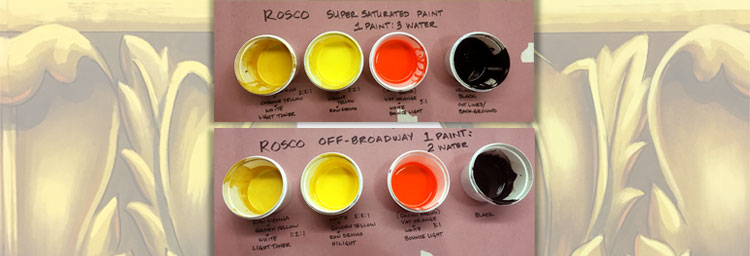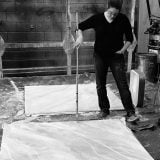Throughout our painting adventures, many of us have used Rosco paint products on one project or another. Maybe, while choosing which paint products to use, questions about the differences in Rosco products have become a head scratcher. There are several options for artist paints within the Rosco line, two of the most popular are Rosco Off Broadway, and Rosco Supersaturated paints.
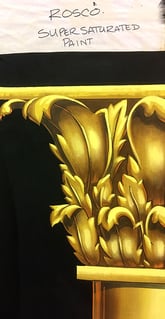 During her career, Jamie Clausius – the Resident Scenic Artist at Tobins Lake Studios – has used all of Rosco’s paints. After a recent examination of both Off Broadway and Supersaturated, she reached out to share her findings. Her comparisons of the similarities and differences of the two paint lines are below.
During her career, Jamie Clausius – the Resident Scenic Artist at Tobins Lake Studios – has used all of Rosco’s paints. After a recent examination of both Off Broadway and Supersaturated, she reached out to share her findings. Her comparisons of the similarities and differences of the two paint lines are below.
Similarities
Since both Off Broadway and Supersaturated are made by the same manufacturer, there are many similarities to each paint ‘system.’ Both paints are water-based acrylics that can be used together when mixing and painting. Rosco’s suggested application process states each system of paint can be applied with either a brush, roller or sprayer and both paints are formulated to be diluted with water. If applying the paint to a hard surface, priming is strongly recommended. Tough Prime is another Rosco product recommended for priming, however almost any trusted primer will be successful.
Differences
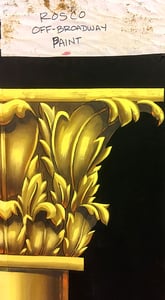 The main difference between the two paint systems is their dilution ratios. Off Broadway is intended to be used for ‘fat’ coats (thick or opaque paint application) and should be used either straight from the can or in a 1-part paint to 1-part water ratio. Supersaturated paint features a much higher concentration of pigment within the paint, enabling it to be diluted at a much higher rate than Rosco Off Broadway. Because of this formulation, the paint can be watered down 4-parts water to 1-part paint for opaque applications, or as much as 15-parts water to 1-part paint for creating translucent glaze effects, or toning techniques such as shade and shadow. The more the paint is diluted, however, the weaker the binder within the paint becomes. When first working with Supersaturated paint, it is important to pay attention to the consistency of the paint and understand how the paint acts as it becomes more diluted. Sometimes, mixing in a binder, such as Rosco Clear Acrylic Glaze, is recommended to keep the adherence and flexibility of the paint at an optimum level.
The main difference between the two paint systems is their dilution ratios. Off Broadway is intended to be used for ‘fat’ coats (thick or opaque paint application) and should be used either straight from the can or in a 1-part paint to 1-part water ratio. Supersaturated paint features a much higher concentration of pigment within the paint, enabling it to be diluted at a much higher rate than Rosco Off Broadway. Because of this formulation, the paint can be watered down 4-parts water to 1-part paint for opaque applications, or as much as 15-parts water to 1-part paint for creating translucent glaze effects, or toning techniques such as shade and shadow. The more the paint is diluted, however, the weaker the binder within the paint becomes. When first working with Supersaturated paint, it is important to pay attention to the consistency of the paint and understand how the paint acts as it becomes more diluted. Sometimes, mixing in a binder, such as Rosco Clear Acrylic Glaze, is recommended to keep the adherence and flexibility of the paint at an optimum level.
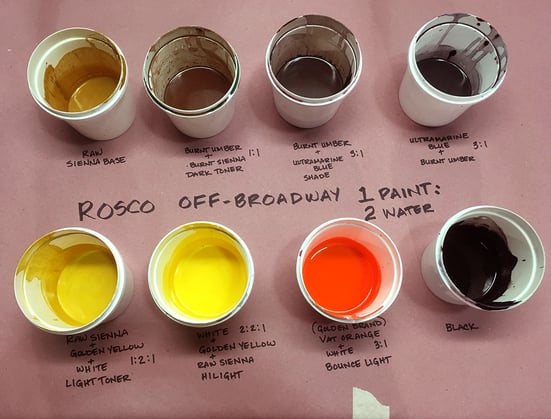 Because Rosco Off Broadway tends to have an opaquer quality to its colors, this makes it ideal for painting hard scenery, metals and rigid plastics. This also makes Off Broadway a good choice for painting exterior scenery or murals.
Because Rosco Off Broadway tends to have an opaquer quality to its colors, this makes it ideal for painting hard scenery, metals and rigid plastics. This also makes Off Broadway a good choice for painting exterior scenery or murals.
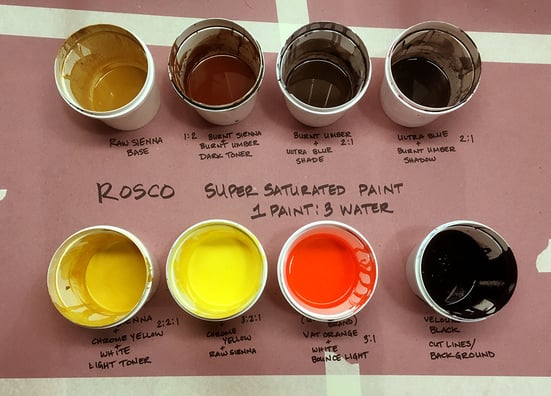 Rosco Supersaturated paints, on the other hand, are ideal for situations in which the painted piece will need to withstand repeated amounts of folding and rolling to resist cracking over time. Because of its high pigment content and flexible binder, Supersats are an excellent option for painting translucent muslin backdrops and scrims that need to be painted with thin paint while retaining vibrancy. The flexible binder also makes it useful for painting on Rosco Projection Screens, or Rosco Marley Dance Floors and, due to its concentrated pigment content, Supersaturated paints are also considered as a safe alternative to toxic aniline dyes. These attributes are why Tobins Lake Studios has specifically switched to Rosco Supersaturated to paint almost all of our backdrops.
Rosco Supersaturated paints, on the other hand, are ideal for situations in which the painted piece will need to withstand repeated amounts of folding and rolling to resist cracking over time. Because of its high pigment content and flexible binder, Supersats are an excellent option for painting translucent muslin backdrops and scrims that need to be painted with thin paint while retaining vibrancy. The flexible binder also makes it useful for painting on Rosco Projection Screens, or Rosco Marley Dance Floors and, due to its concentrated pigment content, Supersaturated paints are also considered as a safe alternative to toxic aniline dyes. These attributes are why Tobins Lake Studios has specifically switched to Rosco Supersaturated to paint almost all of our backdrops.
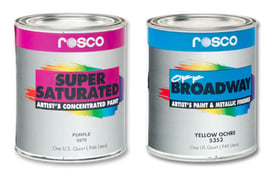 Both of these two paint products are an excellent option for painting most scenic art projects. Whichever one you choose, it’s always strongly recommended to properly test the paint before fully applying it to the final substrate. The “right” choice depends on the requirements of the design, the life-expectancy of the piece and, ultimately, the preference of the scenic artist. Visit the Supersaturated Scenic Paint and the Off Broadway Scenic Paint product pages on Rosco’s website for more information on these two scenic paint products to determine how they will work best in your next production.
Both of these two paint products are an excellent option for painting most scenic art projects. Whichever one you choose, it’s always strongly recommended to properly test the paint before fully applying it to the final substrate. The “right” choice depends on the requirements of the design, the life-expectancy of the piece and, ultimately, the preference of the scenic artist. Visit the Supersaturated Scenic Paint and the Off Broadway Scenic Paint product pages on Rosco’s website for more information on these two scenic paint products to determine how they will work best in your next production.
To see examples of how Jamie Clausius has used Rosco Scenic Paints in her work, explore the rental backdrops at Tobins Lake Studios or visit her website: jamieclausius.carbonmade.com.

